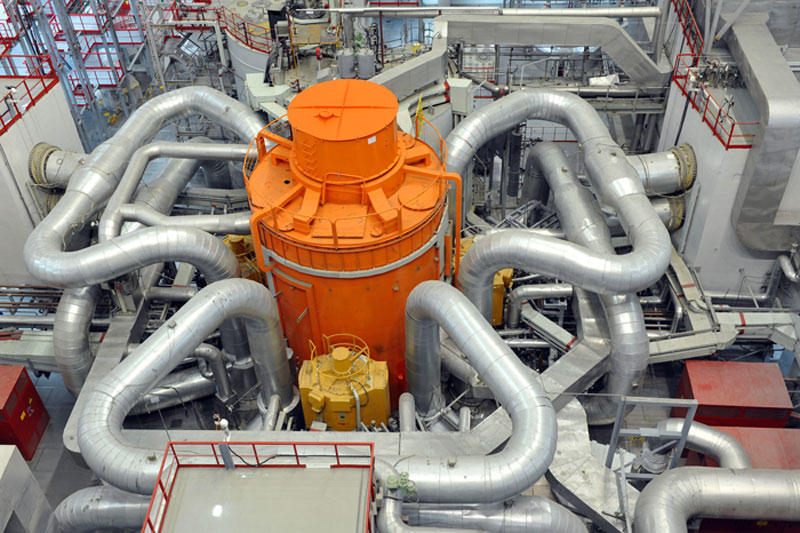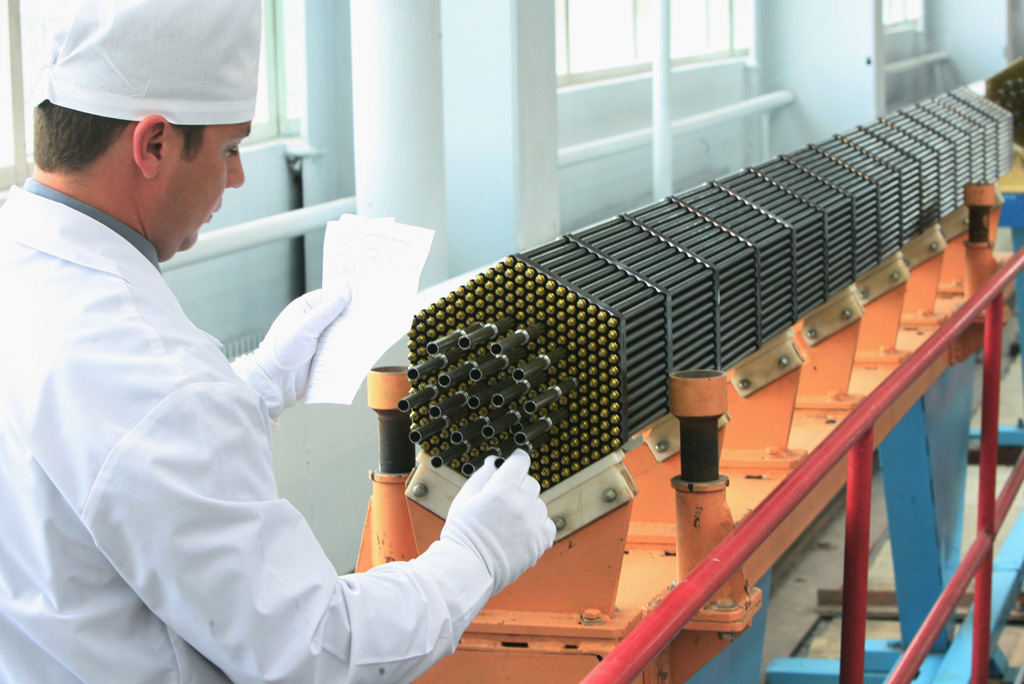|
BN-1200 Reactor
The BN-1200 reactor is a sodium-cooled fast breeder reactor project, under development by OKBM Afrikantov in Zarechny, Russia. The BN-1200 is based on the earlier BN-600 and especially BN-800, with which it shares a number of features. The reactor's name comes from its electrical output, nominally 1220 MWe. Originally part of an expansion plan including as many as eight BN-Reactors starting construction in 2012, plans for the BN-1200 were repeatedly scaled back until only two were ordered. The first was to begin construction at the Beloyarsk nuclear power plant in 2015, with commissioning in 2017, followed by a second unit. A possible new station known as South Ural would host another two BN-1200s at some future point. In 2015, after minor delays, problems at the recently completed BN-800 dictated a fuel redesign. BN-1200 construction was put on "indefinite hold", and Rosenergoatom stated that no decision to continue would be made before 2019. In January 2022, Rosatom ... [...More Info...] [...Related Items...] OR: [Wikipedia] [Google] [Baidu] |
OKBM Afrikantov
OKBM Afrikantov (full name: OAO I. I. Afrikantov OKB Mechanical Engineering, ) is a nuclear engineering company located in Nizhny Novgorod, Russia. It is a subsidiary of Rosatom. The company is named after Igor Afrikantov, and is best known as the main designer for the Soviet Union's and Russia's flagship nuclear propulsion projects, including reactors for nuclear submarines, nuclear-powered icebreakers, and the floating nuclear power plant project. It also designs fast breeder reactors. Nearly 4,000 people work for OKBM, including more than 1,600 design engineers, production engineers and test engineers. The company's employees include one Academician of the Russian Academy of Science, 20 Doctors of Engineering Science and 92 Candidates of Engineering Science. Throughout the years in action, OKBM has made a great contribution to the development of the Russian nuclear industry, the energy sector and the fleet. History The company was founded in 1945, by the decree of th ... [...More Info...] [...Related Items...] OR: [Wikipedia] [Google] [Baidu] |
Breeder Reactor
A breeder reactor is a nuclear reactor that generates more fissile material than it consumes. These reactors can be fueled with more-commonly available isotopes of uranium and thorium, such as uranium-238 and thorium-232, as opposed to the rare uranium-235 which is used in conventional reactors. These materials are called fertile materials since they can be bred into fuel by these breeder reactors. Breeder reactors achieve this because their neutron economy is high enough to create more fissile fuel than they use. These extra neutrons are absorbed by the fertile material that is loaded into the reactor along with fissile fuel. This irradiated fertile material in turn transmutes into fissile material which can undergo fission reactions. Breeders were at first found attractive because they made more complete use of uranium fuel than light-water reactors, but interest declined after the 1960s as more uranium reserves were foundHelmreich, J. E. ''Gathering Rare Ores: The D ... [...More Info...] [...Related Items...] OR: [Wikipedia] [Google] [Baidu] |
BN-800 Reactor
The BN-800 reactor (Russian: реактор БН–800) is a sodium-cooled fast breeder reactor, built at the Beloyarsk Nuclear Power Station, in Zarechny, Sverdlovsk Oblast, Russia. The reactor is designed to generate 880 MW of electrical power. The plant was considered part of the weapons-grade Plutonium Management and Disposition Agreement signed between the United States and Russia. The reactor is part of the final step for a plutonium-burner core (a core designed to burn and, in the process, destroy, and recover energy from, plutonium). The plant reached its full power production in August 2016. According to Russian business journal ''Kommersant'', the BN-800 project cost 140.6 billion rubles (roughly 2.17 billion dollars). Design The plant is a pool-type LMFBR, in which the reactor, coolant pumps, intermediate heat exchangers and associated piping are all located in a common liquid sodium pool. This is similar to the general design of EBR-II, which went into service in ... [...More Info...] [...Related Items...] OR: [Wikipedia] [Google] [Baidu] |
Nuclear Power In Russia
Russia is one of the world's Nuclear power by country#Overview, largest producers of nuclear energy. In 2020 total electricity generated in nuclear power plants in Russia was 215.746 terawatt-hour, TWh, 20.28% of all electric power plant generation. The installed gross capacity of Russian nuclear reactors is 29.4 GW in December 2020. Recent history In accord with legislation passed in 2001, all Russian civil reactors are operated by Rosenergoatom. More recently in 2007 Russian Parliament adopted the law "On the peculiarities of the management and disposition of the property and shares of organizations using nuclear energy and on relevant changes to some legislative acts of the Russian Federation", which created Atomenergoprom - a holding company for all Russian civil nuclear industry, including Energoatom, nuclear fuel producer and supplier TVEL, uranium trader Tekhsnabexport (Tenex) and nuclear facilities constructor Atomstroyexport. The overnight cost of construction in the ... [...More Info...] [...Related Items...] OR: [Wikipedia] [Google] [Baidu] |
Liquid Metal Fast Reactors
Liquid is a state of matter with a definite volume but no fixed shape. Liquids adapt to the shape of their container and are nearly incompressible, maintaining their volume even under pressure. The density of a liquid is usually close to that of a solid, and much higher than that of a gas. Therefore, liquid and solid are classified as condensed matter. Meanwhile, since both liquids and gases can flow, they are categorized as fluids. A liquid is composed of atoms or molecules held together by intermolecular bonds of intermediate strength. These forces allow the particles to move around one another while remaining closely packed. In contrast, solids have particles that are tightly bound by strong intermolecular forces, limiting their movement to small vibrations in fixed positions. Gases, on the other hand, consist of widely spaced, freely moving particles with only weak intermolecular forces. As temperature increases, the molecules in a liquid vibrate more intensely, causing ... [...More Info...] [...Related Items...] OR: [Wikipedia] [Google] [Baidu] |
VVER-TOI
The VVER-TOI or WWER-TOI () is a generation III+ nuclear power reactor based on VVER technology developed by Rosatom. The VVER-TOI design is intended to improve the competitiveness of Russian VVER technology in international markets. It would use VVER-1300/510 water pressurized reactors constructed to meet modern nuclear and radiation safety requirements. The VVER-TOI project is developed on the basis of the design documents worked out for AES-2006, considering the experience gained in development of projects based on VVER technology both in Russia and abroad, such as Novovoronezh Nuclear Power Plant II. The first VVER-TOI will be unit 1 of the Kursk II Nuclear Power Plant. Main technical-economic indicators The reactor design life is 60 years, with potential of life extension to 100 years, and a thermal capacity of 3300 MWt and a gross electrical capacity of 1300 MWe. Project initial requirements # Stability in the terms of critical external impacts and natural disaste ... [...More Info...] [...Related Items...] OR: [Wikipedia] [Google] [Baidu] |
VVER-600
The water-water energetic reactor (WWER), or VVER (from ) is a series of pressurized water reactor designs originally developed in the Soviet Union, and now Russia, by OKB Gidropress. The idea of such a reactor was proposed at the Kurchatov Institute by Savely Moiseevich Feinberg. VVER were originally developed before the 1970s, and have been continually updated. They were one of the initial reactors developed by the USSR, the other being the infamous RBMK. As a result, the name VVER is associated with a wide variety of reactor designs spanning from generation I reactors to modern generation III+ reactor designs. Power output ranges from 70 to 1300 MWe, with designs of up to 1700 MWe in development. The first prototype VVER-210 was built at the Novovoronezh Nuclear Power Plant. VVER power stations have been installed in Russia, Ukraine, Belarus, Armenia, China, the Czech Republic, Finland, Hungary, Slovakia, Bulgaria, India, and Iran. Countries that are planning to introduce VV ... [...More Info...] [...Related Items...] OR: [Wikipedia] [Google] [Baidu] |
Beloyarsk Nuclear Power Station
The Beloyarsk Nuclear Power Station (NPS; []) was the third of the Soviet Union, Soviet Union's nuclear plants. It is situated by Zarechny, Sverdlovsk Oblast, Zarechny in Sverdlovsk Oblast, Russia. Zarechny township was created to service the station, which is named after the Beloyarsky District. The closest city is Yekaterinburg. Early reactors Two earlier reactors were constructed at Beloyarsk: an AMB-100 reactor (operational 1964–1983) and an AMB-200 reactor (operational 1967–1989). The first unit used 67 tons of uranium enriched to 1.8%, while the second unit used 50 tons of uranium enriched to 3.0%. The first unit had an indirect steam cycle, while the second had a direct one. Although they were comparable in power to the Shippingport Atomic Power Station, the Soviet planners regarded the Beloyarsk reactors as prototypes. Their main novelty was the use of superheated steam ran through a standard turbine thus resulting in a better efficiency compared to the earl ... [...More Info...] [...Related Items...] OR: [Wikipedia] [Google] [Baidu] |
Rosatom
State Atomic Energy Corporation Rosatom (commonly referred to as Rosatom rus, Росатом, p=rosˈatəm}), also known as Rosatom State Nuclear Energy Corporation, (), or Rosatom State Corporation, is a Russian State corporation (Russia), state corporation headquartered in Moscow that specializes in Nuclear power in Russia, nuclear energy, nuclear non-energy goods and high-tech products. It was established in 2007 and comprises more than 350 enterprises, including scientific research organizations, a Nuclear weapon, nuclear weapons complex, and the world's only Nuclear-powered icebreaker, nuclear icebreaker fleet. The organization is the largest electricity generating company in Russia, producing 217.4 TWh of electricity, 20.28% of the country's total electricity production. The corporation ranks first in overseas nuclear power plant construction, responsible for 90% of global nuclear technology exports: 22 nuclear power plant units, at different stages of development, in ... [...More Info...] [...Related Items...] OR: [Wikipedia] [Google] [Baidu] |
MOX Fuel
Mixed oxide fuel (MOX fuel) is nuclear fuel that contains more than one oxide of fissile material, usually consisting of plutonium blended with natural uranium, reprocessed uranium, or depleted uranium. MOX fuel is an alternative to the low-enriched uranium fuel used in the light-water reactors that predominate nuclear power generation. For example, a mixture of 7% plutonium and 93% natural uranium reacts similarly, although not identically, to low-enriched uranium fuel (3 to 5% uranium-235). MOX usually consists of two phases, UO2 and PuO2, and/or a single phase solid solution (U,Pu)O2. The content of PuO2 may vary from 1.5 wt.% to 25–30 wt.% depending on the type of nuclear reactor. One attraction of MOX fuel is that it is a way of utilizing surplus weapons-grade plutonium, an alternative to storage of surplus plutonium, which would need to be secured against the risk of theft for use in nuclear weapons. On the other hand, some studies warned that normalizing the global com ... [...More Info...] [...Related Items...] OR: [Wikipedia] [Google] [Baidu] |
World Nuclear Association
World Nuclear Association is the international organization that promotes nuclear power and supports the companies that comprise the global nuclear industry. Its members come from all parts of the nuclear fuel cycle, including uranium mining, uranium conversion, uranium enrichment, nuclear fuel fabrication, plant manufacture, transport, and the disposal of used nuclear fuel, as well as electricity generation itself. Together, World Nuclear Association members are responsible for 70% of the world's nuclear power as well as the vast majority of world uranium, conversion and enrichment production. The Association says it aims to fulfill a dual role for its members: facilitating their interaction on technical, commercial and policy matters, and promoting wider public understanding of nuclear technology. It has a secretariat of around 30 staff. The Association was founded in 2001 on the basis of the Uranium Institute, itself founded in 1975. Membership World Nuclear Association ... [...More Info...] [...Related Items...] OR: [Wikipedia] [Google] [Baidu] |






